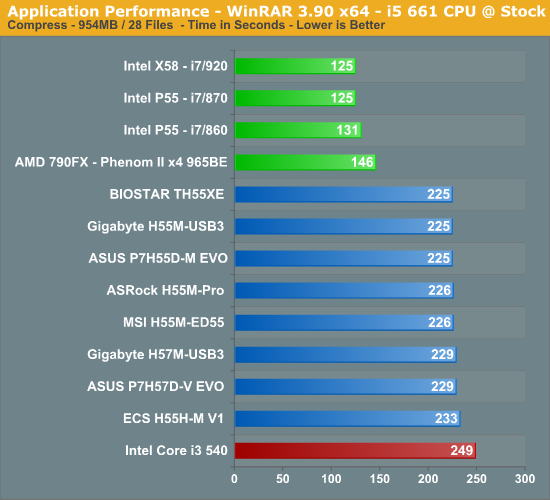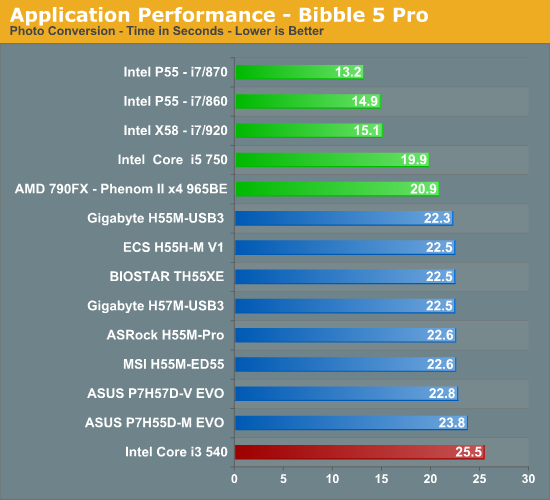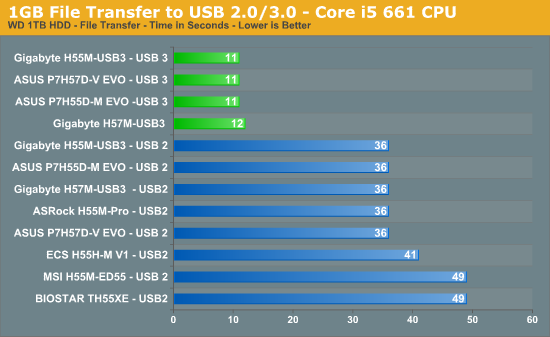Choosing the Best H55/H57 Motherboard, Part 2
by Rajinder Gill on February 22, 2010 2:00 AM EST- Posted in
- Motherboards
Sorenson Squeeze 6
We are using Sorenson Squeeze to convert eight AVCHD videos into HD Flash videos for use on websites. This application heavily favors physical core count and processor clock speed.

WinRAR 3.9 x64
This benchmark compresses our AT workload consisting of a main folder that contains 954MB of files in 15 subfolders. The result is a file approximately 829MB in size.

Bibble 5.0
We utilize Bibble Labs' Bibble 5 v2 to convert 50 RAW image files into full size JPEG images with the program's default settings. This program is fully multithreaded and multi-core aware.

File Transfer to USB
In this test we use Sharkoon's USB 3.0 QuickPort with a 1TB Western Digital hard drive and transfer a 1GB and file from a 1TB HDD connected to the Intel PCH.

We've got a couple of stragglers in this test on the USB 2.0 interface; it seems BIOSTAR and MSI have some work to do on the USB side of operation. The general consensus is that USB 3.0 transfer times are around 10 seconds per gigabyte, while USB 2 delivers an average time of 36~40 seconds per GB. We did try some larger transfers and the scaling is fairly close to linear; a 6GB file transfer takes around 3mins 50 seconds on USB 2.0, while USB 3.0 manages the same file in 1 minute 16 seconds. Although the gains provided by the USB 3.0 interface are obvious, external drives only benefit if you use them for reading/writing large files or making complete drive images; random reads/writes are bottlenecked by the HDD seek times and USB latency.










56 Comments
View All Comments
michal1980 - Monday, February 22, 2010 - link
Sounds good.I always wondered how the referance board's preformed. And now as I get older, would consider one if its more stable out of the box then some 3rd party boards.
When I was younger, ie worked less, had more time to tweek systems, an issue or two, or even a few wasnt a big deal. Now I'd like to be installing the OS as soon as everything is screwed togther, and not have to worry about some setting not working.
7Enigma - Monday, February 22, 2010 - link
Thank you for finally putting these mobo companies in their place. The inability to release these boards with even rudimentary function has gone on long enough and by you not only mentioning the issues, but more importantly, by not giving awards is more than a small step in the right direction.While I did not fully read each and every page (I'm not currently in the market so the overview of the platform and conclusions were relevant), your analysis seemed very thorough.
Congrats!
FATCamaro - Monday, February 22, 2010 - link
It still doesn't seem like any of these boards is ready to build a ROCK solid stable system around like in the era of the old BX-chipset days. That said why did you not compare the intel H55 board. I would like to know how good and stable they are. I don't just mean that it can run a CPU benchmark, but how does the network and sound and usb handle wake from suspend, memory compatibility etc. I am leaning towards the intel H55 board.marc1000 - Monday, February 22, 2010 - link
why is it so hard to choose a good board for this platform, that it takes two articles with almost 10 pages each in a graduated site like this to aid people in the choice???i say this platform is bogus, by design. not that the system is faulty and etc, but everything was made "so fast" that intel did not test the design properly... so, i repeat what i said in the first article: I, as consumer, will simply "skip" this generation of CPU's. maybe in the next iteration everything will be more polished.
Rajinder Gill - Monday, February 22, 2010 - link
Hi Marc,There's probably some blame on both sides (Intel & sub-vendors), for some of the required fixes. Stuff like AHCI, and testing if four memory modules boot or are stable are a responsibility of the sub-vendor prior to public BIOS/board release though.
It's always wise to wait a few months before jumping on a new platform. There is room for improvement in some areas as pointed out above, but the advice to wait is ALWAYS sound.
The reason it took 10 pages per article and the time it did is mainly down to how much testing is involved (stability, peripherals, benchmarks + the time it takes to pen it all down).
later
Raja
JonnyDough - Wednesday, February 24, 2010 - link
Any idea how we can get OEM vendors to update their bios's for longer periods of time? Why is it we have to pay a fee to Phoenix for updated bios' when the OEM is no longer willing to carry the updated version?semo - Monday, February 22, 2010 - link
They keep doing the same thing over and over again. If they have that many problems with their most popular products imagine what happens to their lesser known parts.We've finally noticed a trend in a batch of PCs at work that keep crashing or failing to boot with Asus P5LD2-TVM-SE-SI-1394 mobos. They've admitted it finally but we've had this issue for 2 years already. We're lucky our OEM supplier can put big pressure on them but if we were a small company then we'd stand no chance of even getting an acknowledgment
cactusdog - Monday, February 22, 2010 - link
"at least until SATA 6G peripherals are affordable"Western Digital have just released a 1T Sata 6Gbs drive and its not much more expensive than a Sata2 drive. A review on it would be nice.
Anyway nice roundup.
Ben90 - Monday, February 22, 2010 - link
Because it has the exact same performance as a SATAII driveRajinder Gill - Monday, February 22, 2010 - link
Thanks. You're right - I should have written SATA 6G SSD's..regards
Raja